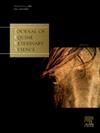濒临灭绝的泰州马品种表型性状的遗传特征及其育种策略。
IF 1.3
3区 农林科学
Q2 VETERINARY SCIENCES
引用次数: 0
摘要
台州马是濒临灭绝的日本本土品种。对濒危马种的罕见表型的致病基因进行基因分型非常重要,因为如果不制定保护育种策略,独特的遗传特征就可能会丧失。本研究对 56 匹泰州马的毛色、身体成分和步态相关的 9 个基因中的 9 个单核苷酸变体和 3 个嵌合体进行了基因分型。其中,只有三个基因具有多态性。观察到的毛色表型与根据基因型估计的表型一致,而黑马则表现出特定的表型,冬季一般为黑色,夏季则变成浅棕色。未发现配体依赖性核受体核心抑制因子样基因的 DNA 多态性,也未发现肌动蛋白基因的极少数多态性。虽然肩高、胸围、炮围和体长的平均值分别为 122.8 厘米、143.1 厘米、16.9 厘米和 130.2 厘米,但没有发现所研究的变异与身体成分测量之间有任何关系。没有观察到与doublesex和mab-3相关的转录因子3基因的步态等位基因,估计的表型与观察到的表型(小跑)一致。台州马的毛色基因型对于制定育种策略以保护黑马和栗马至关重要,因为黑马和栗马的数量远远少于骝马。这些结果可能有助于育种者构建育种策略,以保护该品种的稀有表型特征。这一举措也将有益于其他日本本土马匹的育种计划,如数量正在减少的野间马和宫古马。本文章由计算机程序翻译,如有差异,请以英文原文为准。
Genetic characterization of phenotypic traits in endangered Taishu horse breed and their breeding strategy
The Taishu horse is a native Japanese breed threatened with extinction. It is important to genotype the causative genes of rare phenotypes in endangered breeds because unique genetic traits might be lost unless a breeding strategy for conservation is constructed. In the present study, nine single-nucleotide variants and three indels of nine genes related to coat color, body composition, and gait were genotyped in 56 Taishu horses. Of these, only three genes were polymorphic. The observed coat color phenotypes coincided with the estimated phenotype from the genotypes, whereas black horses showed specific phenotypes that were generally black in winter but turned light brown in summer. No DNA polymorphisms in ligand-dependent nuclear receptor corepressor-like gene and very few polymorphisms in myostatin gene were identified. While means of withers height, chest circumference, cannon circumference, and body length were 122.8, 143.1, 16.9, and 130.2 cm, respectively, no relationship was found between the variants investigated and the body composition measurements. The gaited allele of doublesex and mab-3 related transcription factor 3 gene was not observed and the estimated phenotypes coincided with the observed phenotype, trot. Genotypes of coat color in the Taishu horses are essential for the construction of breeding strategies to conserve black and chestnut horses, which are much less common than bay horses. These results may help breeders construct breeding strategies to conserve rare phenotypic traits in this breed. This initiative will also be beneficial for breeding programs of other native Japanese horses, such as Noma and Miyako, whose numbers are declining.
求助全文
通过发布文献求助,成功后即可免费获取论文全文。
去求助
来源期刊

Journal of Equine Veterinary Science
农林科学-兽医学
CiteScore
2.70
自引率
7.70%
发文量
249
审稿时长
77 days
期刊介绍:
Journal of Equine Veterinary Science (JEVS) is an international publication designed for the practicing equine veterinarian, equine researcher, and other equine health care specialist. Published monthly, each issue of JEVS includes original research, reviews, case reports, short communications, and clinical techniques from leaders in the equine veterinary field, covering such topics as laminitis, reproduction, infectious disease, parasitology, behavior, podology, internal medicine, surgery and nutrition.
 求助内容:
求助内容: 应助结果提醒方式:
应助结果提醒方式:


